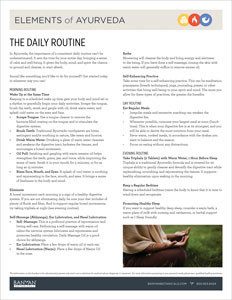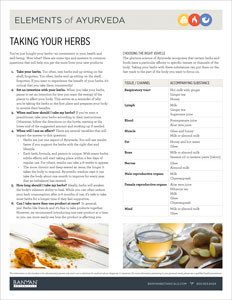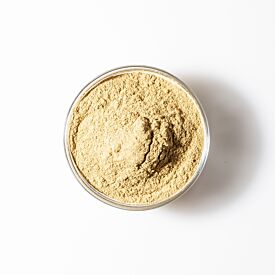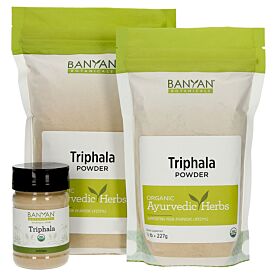Kapha Pacifying Daily Routine
Nearly everywhere we look in nature, there are creatures engaging in some sort of consistent daily routine. The natural world at large is deeply influenced by the rhythms of nature—the rising and setting of the sun, the cycles of the seasons, and the underlying impulses directing the broader community of life.
While there is often some degree of seasonal variation, many plants and animals embrace a predictable daily rhythm and, as a rule, live by it.
As humans, we have largely gotten away from this habit. Modern forms of energy allow us to heat and cool our homes and businesses, light the darkness, and engage with life at all hours of the day and night. Many of us even have jobs and other obligations that require us to keep irregular schedules.
The increasingly erratic nature of our lives is inherently taxing. Layer that on top of the busyness and stress that pervades modern life, and it is no wonder that so many of our nervous systems now exist in a chronic state of high alert—hyper-vigilant, increasingly unable to relax.
Actually, this is precisely why the daily routine is such potent medicine. In effect, having a daily routine offers the grounding, stability, and predictability that are largely absent from our hectic modern lives.
The routine itself creates a number of familiar and comforting reference points throughout each day that send a resounding affirmation to the deep tissues of the body that all is well, that we can be at ease.
And so, when the body becomes accustomed to—and learns to count on—a daily routine that includes things like adequate rest, appropriate exercise, and a nourishing spiritual practice, the nervous system can finally begin to relax.1
As a result, a daily routine can elicit profound rejuvenation throughout the body without requiring any conscious awareness of the healing process.
But adopting a daily routine is also a very purposeful and enduring act of self-love. Each day, our routines provide us with a tangible opportunity to prioritize our own health and wellbeing, regardless of what else might be going on in our lives. They quickly become poignant reminders that we are in fact worthy of a healthy dose of loving attention every single day.
The cumulative effect of caring for ourselves in this way is quite powerful. And for many, committing to a daily routine results in a greatly improved sense of wellness in a very short period of time.
Creating a Manageable Routine
Some aspects of an Ayurvedic daily routine are very quick and easy to incorporate into your day, regardless of your schedule. Other practices require some concerted effort and a strong level of commitment. If establishing a daily routine is entirely new to you—and even if it isn’t—it’s important not to get overwhelmed.
As you can imagine, taking on too much too soon tends to cause more stress than it relieves, so it’s important to be realistic about how much you should start with. A good strategy might be to add as many “little things” as you feel truly inspired to do, and then to take on only 3–5 more significant commitments.
If you tend to make things too easy for yourself, err on the side of 5 substantial new additions to your day.
And no matter how appealing each practice may sound, it is far more important to be able to stick to your commitments consistently than to try to do everything. A routine can have a soothing effect on your entire organism, but much of the benefit will be lost if you can’t do it regularly. In this respect, less truly is more.
Remember, the idea is to facilitate a sense of predictability in certain aspects of your life so that your being has a place to come home to throughout the day—regardless of what other curve balls might crop up as your day unfolds. You will always be able to add to your routine later.
In fact, as time goes on, you may notice that your routine becomes almost effortless. Instead of pouring a bunch of energy into making it happen every day, it simply becomes habit and you no longer have to think about it. This is the time to think about layering in new practices.
Where to Begin?
If you read the classic texts of Ayurveda, one thing stands out about the recommended daily routine: it is heavily focused on the early morning hours. Most of the recommended practices are done upon waking and are completed before breakfast. Consider the cosmic peace and serenity that is accessible in the hours just before sunrise.
This time of day embodies an inherent stillness. It is as if the entire atmosphere is imbued with the qualities of tranquility, peace, compassion, and love.
As a result, the early morning hours are an especially powerful time to engage in loving self-care, reflective practice, and the intention to heal or re-pattern the physiology. Beyond that, this is the timeframe that sets the tone for our entire day. Which is to say, the early morning is a great place to start when establishing a routine.
When we care deeply for ourselves every morning, we create enormous potential for positive change—truly transformational potential. Changing your morning really can change your life.
The Traditional Ayurvedic Morning Routine
What follows is a brief description of a traditional Ayurvedic morning routine. Remember, this is the ideal. Please do not try to do all of this tomorrow morning. We’ve included all of these practices and a brief description of their benefits because different elements of the routine will speak to different individuals.
As you read through this list, pay close attention to which elements stir the deepest response in your body. Those practices will usually be the best ones to start with.
Wake Up Between 3 a.m. and 6 a.m.
The classics recommend that we rise during the “ambrosial hours” of the morning, sometime between 3 a.m. and 6 a.m.2, 3 This is a vata time of day; the atmosphere is infused with lightness and clarity, which helps us to more easily awaken.4
Equally important, this time of day is regarded as being the most conducive for creating a connection with our deepest inner nature and consciousness. Waking during this particular timeframe is not necessary for children, the elderly, or for those who are sick, pregnant, or breast-feeding.4
Regardless of what time works best for you, your daily routine will be most beneficial if you wake up at a consistent time from one day to the next.
Eliminate
Empty the bladder and the bowels. Ayurveda views morning elimination as a natural and essential element of daily hygiene and health. If you do not typically have a bowel movement first thing in the morning, some of the below practices (like drinking warm water) may help you regulate this function in your body.
Or, consider taking triphala to support healthy and regular elimination (see Evening Routine below, for more on taking triphala).
Scrape Tongue

This simple hygiene practice removes bacteria and toxins that have accumulated on the tongue overnight.4 It also serves to stimulate and cleanse the digestive tract and the vital organs. So while tongue scraping is considered an important element of daily oral hygiene, it also supports the natural detoxification of the system at large.
Another benefit of scraping the tongue is that it allows us to take notice of the coating on our tongues each morning and to begin to see how our dietary choices and lifestyle habits influence our overall health from one day to the next.3
A tongue cleaner made of stainless steel is balancing for all doshas. When you are finished, rinse with clean water and spit.
Brush Teeth
While this practice is already familiar to all of us, Ayurveda recommends cleaning the teeth with herbs that promote oral health, which are typically bitter, astringent, or pungent in taste.4
Try Tooth Powder, a powdered blend of Ayurvedic herbs and minerals, including neem, amalaki, miswak, and charcoal, that leave your mouth feeling clean, polished, and refreshed.
Drink Warm Water
Drinking a glass of warm water cleanses and awakens the digestive tract, hydrates the tissues, and promotes peristalsis—which can encourage a bowel movement, even when there is a tendency toward sluggishness or constipation.
It is best to drink water only after the mouth and the tongue have been cleansed so as not to swallow the bacteria and toxins that have accumulated in the mouth overnight.3
Swish and Gargle with Daily Swish Pulling Oil
It is said that swishing and gargling with warm oil like Daily Swish lends strength to the teeth, gums, jaw, and voice while improving the sense of taste.3 Spit the oil out after you have held and swished it in your mouth for the desired period of time.
This practice can be done briefly, for 1–2 minutes, or for as long as 15 minutes. If a longer swish and gargle is appealing, consider doing it during abhyanga (see below), or while completing other aspects of your morning routine.
Massage Gums with Daily Swish Pulling Oil
Use your clean index finger to gently massage a bit of Daily Swish oil into your gums. This practice further benefits the teeth and gums by increasing circulation in these tissues and encouraging absorption of the oil.3, 5
Splash Cold Water in the Eyes
Our eyes work very hard all day and they tend to accumulate a lot of heat. Splashing a bit of cold water into each eye in the morning helps to cool, soothe, and relax the eyes, but also helps us to feel more vibrantly awake.
Meditation, Pranayama, Prayer, or Quiet Reflection
If the central purpose of a morning routine is to calm the nervous system and ground the being before the day begins, then meditation, pranayama, prayer, or quiet reflection are perhaps its most essential elements.
You may already have a practice that speaks to you. If not, simply sitting quietly and breathing slowly and deeply for a few minutes can have a tremendously beneficial effect.
If you’re looking for a soothing and powerful introduction to breath work, Dr. Claudia Welch’s Prana CD consists of four guided breathing exercises that can be practiced in sequence or individually.

Movement
Making time to move our bodies in an appropriate way in the morning is both energizing and motivating. It supports natural detoxification by promoting healthy circulation and by helping to move stagnation from the organs and tissues. It also helps to loosen and awaken the body and the joints.
Early morning is a very supportive time for almost anyone to exercise because of the strengthening and stabilizing influence of kapha, (which is prevalent in the atmosphere from about 6 a.m. to 10 a.m.). If it is not possible for you to exercise in the early morning, early evening is a good alternative (about 6 p.m. to 10 p.m.), preferably before dinner.
-
Yoga. As a sister science of Ayurveda, yoga is a natural part of an Ayurvedic daily routine. However, different individuals will benefit from different types of yoga, depending on their constitution and current state of balance.
For kapha-predominant types, a more invigorating form of yoga—such as kapha-pacifying yoga—that emphasizes strengthening and stimulation is usually most appropriate. -
Other Forms of Exercise. Ayurveda recommends different types and intensities of exercise for different constitutions and imbalances. In general, Ayurveda suggests that we exercise to only about 50% of our capacity—until we break a mild sweat on the forehead, under the arms, and along the spine, or until the first sign of dryness in the mouth).5, 3
For kapha-predominant types, the ideal exercise program is typically quite vigorous and challenging. Appropriate forms of exercise for kapha types include brisk walking, jogging, biking, hiking, martial arts, and other forms of strength-building, aerobic exercise.
Abhyanga (Ayurvedic Oil Massage)
This ancient practice of self-massage with oil calms the nervous system, lubricates and rejuvenates the tissues, and promotes healthy circulation throughout the body. It is no coincidence that the Sanskrit word for oil, sneha, also means love.
Abhyanga is a profound practice of rejuvenation and loving self-care that benefits both the physical body and the more subtle realms of consciousness.
Each morning, before a shower or bath, massage about 1/4 cup warm Kapha Massage Oil or Sesame Oil into the skin.
Apply Warm Oil to the Ears
The ears are closely related to vata dosha. Regularly lubricating the ears with warm oil like Ear Oil can help pacify vata in general but can also provide other benefits. Known in Sanskrit as karna pratisaranam, the practice of ear oiling is said to support the sense of hearing, prevent stiffness in the neck by lubricating local tissues, and encourage healthy TMJ function.3
To practice ear oiling, use the tip of your pinky finger or a ball of cotton to lubricate the inside of each ear with a bit of Ear Oil, or simply use the dropper to place 1–2 drops of oil in each ear, then massaging the outside of the ear after.
Karna purana, the practice of filling the ear canal with warm oil, can also be practiced monthly with Ear Oil. This can provide deeper lubrication and groundedness to vata.
(Please note that if there is any current or chronic discomfort in the ears, we strongly encourage you to consult a practitioner before attempting either of these practices.)
Apply Warm Oil to the Top of the Head
Oiling the head and scalp is deeply soothing and can help to prevent headaches, hair loss, and greying. It also supports each of the sense organs and encourages sound sleep.3
Foot Massage
Our feet literally carry us through each day. Massaging them each morning, focusing on the soles in particular, is a very grounding and nurturing practice. But because various points on the feet correlate with organs and tissues throughout the body, it also supports proper vision, relieves stress, and offers many other systemic benefits.3
Cleanse or Lubricate the Nasal Passages
There are two Ayurvedic practices that support clean, clear nasal passages and clarity of mind. Both of these practices are best done on an empty stomach, usually early in the morning.
- Nasya. Applying Nasya Oil to the nasal passages can help soothe these delicate tissues, promote unobstructed breathing, relieve accumulated stress, and support mental clarity. This practice is also said to improve the quality of the voice and to strengthen vision. Nasya should not be performed by pregnant or menstruating women.
Each morning, find a comfortable place to lie in the supine position (on your back), tilting your head upside down. You may find it helpful to hang your head off the edge of a bed or bolster so that the top of your crown is parallel with the floor.
Once in position, apply 3–5 drops of Nasya Oil into each nostril, sniffing the oil inward and massaging the face, forehead, and scalp to encourage the oil to move up into the sinuses and head. Relax for a minute or two to allow the oil to absorb before slowly getting up.
- Nasal Rinse. Nasal rinse is a practice of pouring warm salt water through the nasal passages to moisten the mucus membranes and cleanse the nasal passages of dust, dirt, pollen, and excess mucus.
If you find that your nasal passages feel dry afterward, you can use your pinky finger to lubricate the nostrils with a bit of sesame oil or ghee when you’re finished or at another time of day (i.e. as part of your bedtime routine).
Massage the Body with Dry Powder
Garshana is the practice of massaging the body with soft powders (like chickpea or rice flours). It stimulates movement of the lymph, balances kapha, encourages circulation, liquefies fat, bolsters the health of the skin, and lends strength and tone to the tissues of the body.3 It can also help to remove excess oil from the skin following abhyanga.
Bathe
Bathing is a very important part of the traditional Ayurvedic routine. It is said to cleanse and purify the body, to bring energy and alertness to the being, and to promote longevity.5 Use soap only where necessary. If you’ve done abhyanga, rinsing the skin with warm water will generally suffice to remove excess oil.
Breakfast Time
Establishing a consistent time for breakfast is a great way to ensure that we have time to eat our first meal mindfully and that we start our day well-nourished. The content of your breakfast should be seasonally appropriate and supportive of your unique constitution or imbalance.
During the Day
While the bulk of a traditional Ayurvedic routine is performed in the morning, there are a handful of things that we can do throughout the day to enhance the benefits of having a daily routine.
Establish Consistent Times for Meals
This is a very simple way to create consistency for our bodies. It supports digestion, ensures that we eat at optimal times, reduces the propensity for snacking, and helps calm the nervous system by establishing another predictable pattern that our bodies can rely on.
Establish Lunch as the Main Meal
The digestive fire is strongest at mid-day, from about 10 a.m. to 2 p.m. This is therefore the best time to eat our main meal—especially for kapha-types, who can easily tend toward sluggish digestion. This also allows us to enjoy a lighter evening meal, which supports sound sleep and deepens the body’s capacity for rejuvenation each night.
Implement a Consistent Work Schedule
While this is not entirely possible for everyone, do it to the extent that it is possible for you. This provides another avenue toward predictability and supports a deeper sense of calm within the nervous system.

Keep an Appropriate Pace
Sometimes, it is important for kapha-types to honor their own internal pace—which may be slow and steady—as opposed to the vata or pitta tendencies to be frantic or obsessive. Our culture tends to shame being slow, but for kapha-types, slow and steady usually works.
That said, kapha loves the sense of leisure, so an appropriate pace may also mean finding a wellspring of motivation to push through any heaviness that starts to drag us down.
If we can balance honoring who we are with reaching for our personal best, we can begin to re-pattern one of kapha’s core struggles and ultimately, are much better equipped to keep kapha healthy and balanced.
Allow Adequate (But Not Excessive) Time for Rest
Again, kapha tends to overindulge in rest rather than skimp on it. Rest is indeed important and rejuvenating, so make sure you are getting enough, but be honest with yourself about how much you need (for most kapha-types, around 7 hours per night is plenty).
If you’re waking up sluggish, chances are you’re sleeping too late or for too many hours.
Designate Time(s) to Take Herbal Remedies
Taking your herbs at the same time each day is the best way to ensure that you take your herbs regularly. It also benefits the body—in much the same way that eating meals at regular times is beneficial.
An Evening Routine
The evening routine is critically important because it lays the foundation for success with the morning routine. An evening routine can be as simple as establishing a consistent dinnertime and bedtime. Or, it can incorporate a few simple practices.
Here are some nice things to consider.
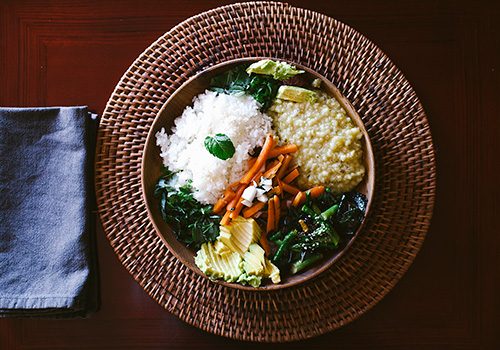
Stick to a Consistent Dinner Time
Ideally, we would eat dinner early enough that our food has time to move completely out of the stomach before we go to bed. This means allowing your body a minimum of 2–3 hours between dinner and bedtime. It may also mean eating a lighter dinner than we might otherwise be accustomed to.
These practices allow for proper digestion, prevent the unnecessary accumulation of toxins, and support healthy sleep patterns.
Take Triphala
Triphala is a traditional Ayurvedic formula comprised of three fruits that are balancing for vata, pitta, and kapha. It is revered for its unique ability to gently cleanse and detoxify the digestive tract while replenishing, nourishing, and rejuvenating the tissues.
About half an hour before bed, steep ½ teaspoon triphala powder in a cup of freshly boiled water for 10 minutes. Cool and drink. Or, take 2 Triphala tablets with a glass of warm water.
Create a Brief “Bedtime Routine”
The idea here is to create a simple series of events that helps to signal your body that the day is winding down and that you will be going to sleep soon. This practice can be incredibly helpful in supporting our ability to surrender to sleep. It is important that these activities be consistent from one day to the next. A bedtime routine might include things like:
- Brushing the teeth
- Washing the face
- Applying oil to the feet and scalp
- Other soothing, quieting activities that appeal to you
Note: Reading in bed is not recommended, as it disrupts the desired association between being in bed and sleeping. If you like to read before bed, designate a specific place—other than your bed—and enjoy.
But keep in mind that reading before bed can be quite stimulating to the eyes and the mind, which can disrupt healthy sleep patterns.
If you tend to struggle with disturbed sleep, you might want to try giving up your bedtime book for a while to see if you notice a difference in your quality of sleep.
Establish a Consistent Bedtime
The trick here is to be consistent. Having predictable sleep and wake times helps our bodies naturally attune to a daily rhythm. It is often helpful to work backward from your desired wake time and establish a sleep time that ensures that you get enough rest each night without being excessive.
This is a beautiful way for us to honor our need for sleep and to ensure that an appropriate amount of rest is built into each day.
Other Considerations That May Alter Your Routine
You may also find that there is good reason to deviate occasionally from this traditional kapha-pacifying routine.
Seasonal Adjustments
Each of the seasons arrives with its own unique personality. We can support an improved state of balance throughout the year by making a conscious effort to live in harmony with the cycles of nature and by making small adjustments in our routines in order to accommodate the arrival of each new season.
For more information on how you might adapt your routine as the seasons change, you can explore these seasonal guides:
Ayurvedic Guide to Summer
Ayurvedic Guide to Autumn
Ayurvedic Guide to Winter
Ayurvedic Guide to Spring
Adjustments for Imbalances
Similarly, if we are dealing with imbalances that do not line up precisely with our constitutions, it is often helpful to adopt a routine that pacifies the dosha(s) that are most aggravated. If you are unsure of your current condition, you can take our dosha quiz.
If you know your current imbalances and would like to adapt your routine to better support those doshas, you can view the other daily routine guides here:
Vata Pacifying Daily Routine
Pitta Pacifying Daily Routine
Vata-Pitta Pacifying Daily Routine
Vata-Kapha Pacifying Daily Routine
Pitta-Kapha Pacifying Daily Routine
Tridoshic Daily Routine

